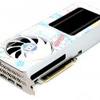Final words and conclusion
Final words
Graphics cards are quite exotic to obtain these days, and this Bilibili version is even harder to obtain targeted in Asia predominantly and being limited to a number of units as well. Nonetheless, it's quiet in the GPU review arena, ergo why not review this one eh? Let's start with the defaults. When it comes to graphics cards, the GeForce RTX 3060 is a compelling option if only it could be obtained for the claimed price of 329 USD. The reality is that the world is a place where component shortages and cryptocurrency miners have hogged every GPU they can get their hands on, also COVID is driving a higher demand for home PC gaming. All of these elements combine to create an absurd concoction of shortages and price increases. NVIDIA did impose a restriction for miners for the 3060, which should hopefully be beneficial. The performance of the card series as a whole is only passable at best. We do want to point out that the performance varied quite a bit depending on the game title. Overall, I'd say the RTX 2070 and the Radeon RX 5700 series from Team Red are the closest contenders in terms of performance (albeit they lack DXR, DLSS, and 12GB of memory). However, while we had hoped that NVIDIA would have enabled the whole shader processor stack, this is not the case, and as a result, the performance is sometimes seen to be lacking for a product at this price point. For this reason alone, the GeForce RTX 3060 Ti would be my first choice over the non-Ti mode, despite the fact that it has fewer graphics memory than the former. Although the GeForce RTX 3060 is a product series that we can still suggest if the price is good, we do not recommend it for those looking to spend more than 300 to 350 USD on something that has x060 in its name.
NVIDIA never offered a reference product, hence the base RTX 3060 entry was simply downclocked to reference clock speeds, as shown in the figure above. A performance gap of about up to 2 percent is revealed on a spread of games at 2560x1440, according to this analysis. Depending on the resolution and gaming application, you could achieve a 3 percent or 4 percent hit rate. Based on a 100 FPS average spread, this means that the (average) difference between the reference and fastest cards is approximately 2 to 4 frames per second.
It does, however, offer performance levels in that RTX 2070 range, with the added benefit of 12 GB GDDR6 graphics memory included, and that I deem to be a sweet spot for the gamers that have a monitor with a resolution of up to 2560x1440. For some easier on the GPU gaming titles, perhaps Ultra HD as well. It's simply going to appeal to many people as drop it in, connect it, install a driver, and frag away. I like that. And if you want a bit more bling inside that rig, hey there are other options. Let's break down the test results though.
Cooling & noise levels
You've seen the FLIR images; the card is hardly even illuminating up, but it's nothing to be concerned about at this point. Temperatures under stress load are around 65 degrees Celsius, which is normal. Yes, this is not premium-level silence in terms of acoustics; you can notably hear the card, but only at regular levels of intense gaming. There are significantly more competing products available on this front than there are on the previous one when it comes to acoustics.
Energy
More recently, we changed the way we measure power consumption to bring you more precise numbers. Pulling manufacturer registers with, say, Afterburner creates the problem that you never know precisely what you are measuring. TGP versus TDP versus TBP. With our new methodology, we accurately measure the graphics card's power feeds, that's the PCIe PEG connectors and PCI-Slot. As such, we display the total board power. I mean, you can measure the GPU solely (TGP), but you also feed other components, like Memory, ICs, and let's not forget cooling and RGB. This card reveals a typical gaming power draw of ~170 Watt (typical).
Coil whine
The card exhibits only minor amounts of coil squeal, very little, and it's hard to hear. In a closed chassis, that noise would fade away in the background. Graphics cards all make this in some form, especially at high framerates; this can be perceived.
Pricing
We have to discuss pricing though; the generic MSRP of the GeForce RTX 3060 sits at the 329 USD marker. This card ex-backplate and factory tweak costs 329,- (at least it should be priced like that). The version tested however is the factory tweaked one. Yes, it'll squeeze a bit more fragging powah on your monitor, but the price premium is precipitous, 389 USD. So that's 60 bucks for premium.
Tweaking
Right out of the box, the graphics card has been tuned to perform optimally. However, it is possible to manually push it more beyond. Memory speeds of 16 to 16.5 Gbps are easily achievable, with Boost speeds of 100+ MHz or more, and for the lucky few, even a notch higher (this is on top of the factory optimization). It is critical that you move the power limiter open. Increased power budget enables the GPU to perform what it does best: accelerate the process of rendering images. When combined with the changes mentioned on the OC page, you should be able to achieve a boost frequency in the range of 2050 MHz. It prefers more air to breathe since the 3060's memory bandwidth is limited by the 192-bit wide memory bus on which it operates. With the 1.70 Gbps (effective data rate) optimization, we were able to implement, you will notice a significant increase in performance. When used in conjunction with the turbo in the 2000–2050MHz range. Keep in mind that values vary depending on the workload and, consequently, the game title. Remember that in order for our change to be considered real, it must pass four games in a full benchmark run at Ultra HD in order to be considered reliable.
Conclusion
While I had hoped for a product that was a little more silent, I am pleased with it anyway. The Bilibili version of course is a card you'll be hardpressed to find. However similar cards with a slightly different theming are available and will perform close to the same. as this one. As a product we have little to complain about, the acoustics could and should be better though. Other than that we will have no complaints. The general appearance of the card is interesting, albeit a little sultry. The performance is a notch above baseline, and if you make a manual change to it (tweak), you'll see an increase of at least 5 up-to 10 percent in overall performance. The 12 GB GDDR6 is an excellent value that will last you well for at least a few years in terms of VRAM requirements. The performance does not disappoint; in fact, I would say that it is basically on par with an RTX 2070, which is the best comparison I can think of. If you stick with a resolution of 2560x1440, you'll be able to play some games that use Hybrid raytracing as well. While we don't care about raytraced shadows in the least, it's the clarity of the raytraced reflections that make the difference for me. Take, for example, driving through London in Watch Dogs: Legion or looking at water and fire reflections in Battlefield V; these are the types of things that create a noticeable difference. In order to get the most out of it, you'll get DLSS 2.0 compatibility in your video games as well. All of these variables have already been incorporated into the RTX 3060 for your convenience. Certainly, the card is not a powerhouse, but it is capable of allowing you to frag along at respectable framerates. A nice little card that delivers respectable performance in the 2560x1440 WQHD resolution domain; the cooling is certainly enough, albeit the acoustics are on the threshold of acceptable. The GeForce RTX 3060 overall remains an attractive product in that 2560x1440 resolution domain, pricing and availability however remain its biggest challenge.
Download NVIDIA GeForce drivers
Sign up to receive a notification when we publish a new article.
Or go back to Guru3D's front page
- Hilbert, LOAD"*",8,1.



